The Musician's Room: My Backline
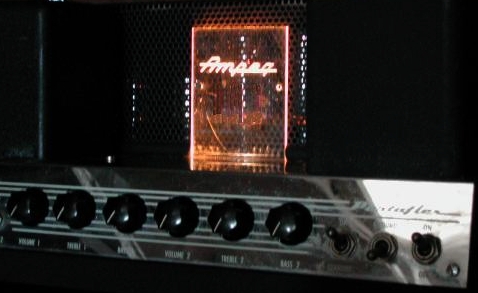
While most "civilians" view the backline as "ugly black boxes," for me there has always been a certain magic in that jumble of amps, speakers, and paraphenalia behind the players. Remember Ampeg B-15 Portaflexes with their cool, understated lighted logo? (See above) Pat Simmons of the Doobies had one of those in 1973. As I waited in the dark for the very first rock concert of my life, that thing glowed at me from the stage. Remember Jewel Lamps? I think I missed them the most of anything during one phase of amp design. Apparently I wasn't alone, because they are the latest rage all over again.
Remember going to the used gear room at the guitar shop? A really good guitar shop had stacks and stacks of used, dusty "blackwares:" cabinets, amps, pedals. The guy would say, "Hey, check this out, it just came in: A Unicord fuzz box with a remote footswitch so you can keep the controls near you on top of your amp! Look at this! No more fiddling with tape loops because this Univox has a CARTRIDGE!" But before we bury ourselves in the "good old days," let's remember the effects like the old Foxx Distortion Booster which could easily eat a batterty per two-hour set. How about amps with speakers which were perennially under-rated and burned up soon after delivery? How about cabinetry that rattled?
It's funny, some electric guitarists are more picky about their amps than they are about their guitars. I guess I strike a balance in believing that the amplifier has about as much influence on your total sound as your guitar does. As a result, I've have been through a few amps over the years to get to my current rig. Somewhere along the line I discovered that I like open-back cabs and combos better than closed back stacks. Well, anyway, here's some stuff from my backline:
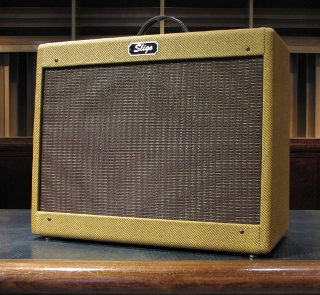 The Need For Tweed
The Need For Tweed
While studying the amps used for many classic rock albums, one name kept coming up: The Fender 5E3 Narrow Panel Tweed Deluxe. I saw these amps mouldering in the back of guitar stores in the 1970s. This little 15 watt design from the 1950s delivers a range of cool and complex vintage sounds via a cathode biased pair of 6V6 tubes that also create natural compression. Through the 12" Alnico speaker, the amp delivers up some excellent, rootsy tones. The hallmarks of the amp from the player's side are exceptional touch sensitivity and ability to be controlled from the guitar's volume control. A guitarist's typical appellation for this amp is, "A minute to love and a lifetime to master." I commissioned an historic reproduction from a custom amplifier builder in my region. More HERE.
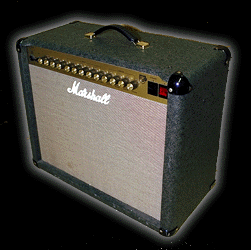 Channel Switching and More
Channel Switching and More
This is a Marshall JTM-612 combo which, like most Marshalls, loves to be pushed! It offers many features for recording and stage performance: channel switching, a balanced direct out, parallel and series effects loops, 60 watts RMS, reverb with individual channel sends, a twelve-inch speaker, compact size, and light weight. Yup, after schlepping large amps and stacks for years, I got tired of the arm-streching exercises before and after each gig. Most Marshalls have a fairly dark clean sound but this one is bright, complex, and pretty. It might be though of as a cross between a JCM800 and a Fender Deluxe Reverb but it really is its own bird.
At low volumes, this amplifier's distortion can get a little fizzy for some people's tastes. After some experimentation, I've found the way to get a great sound: resist jacking up the the boost channel's gain for more sustain. Instead, jack up the channel volume. The result is a nice, smooth sound and some rather pretty distortion. Much like a typical Marshall, this amp DOES love to be driven flat out, and its sound will round out to that very "Marshall-esque" bark (like the Allman Brothers at Fillmore East) when you crank it. When you add an external cabinet, it can hold its own with just about anything else. Oh and by the way, for "Spinal Tap" Fans, these go to 20! This one ran over twenty years before it gave me the first hint of trouble. More, HERE.
 'Yer Basic Fender
'Yer Basic FenderThere are times when you've just gotta have the basic Fender tube combo sound. Sometimes you want a sparkly stringy, clean sound for recording, sometimes you want a California classic rock sound. Whatever, I can't think of any better place to get the classic Fender combo sound than from... a Fender. This is the Fender '65 Deluxe Reverb Reissue. Lots of folks reissue amps and can't help but make little changes to make them "better"... but completely spoil the original sound and feel. Not Fender, not this time. Sure, this is a printed circuit board reissue, but Fender got it right. Every review I've read has respect for this little 22 watt box and for once my ears agree with the reviewers. With its tube rectifier, it gets the springy response just right and the reverb and vibrato are spot on. The preamp does the volume control cleanup and touch response marvelously and the 12" speaker allows for some bass response. It'll hold its own in a small club if you don't mind playing with some gain or it will work well in the studio, either clean or dirty. With the volume at "6" it crunches nicely and with a booster and/or a little compression you can be singing. Not a lot of fancy features, but it sounds sweet. Oh, very noice, indeed!
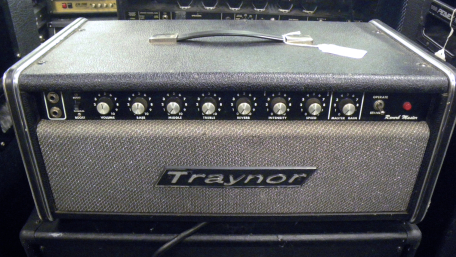 From Master Volume Days
From Master Volume Days
Sometimes you have to think outside of the box. Everyone seems to love the Vox AC-30, Marshall JTM-45, and Fender Blackface amps. What they don't know is that you can get the best of all of these amps in one, very robust and dependable amplifier, the Traynor YRM-1 Reverb Master. This amp was built from 1973 to 1979. It was basically a 45 watt, single channel, Blackface master volume amp featuring EL34 power tubes. It could put out a very nice, Marshall-eque bark, even if a little darker and colder by comparison, but also did the chimey stuff you expect from a Vox. You really could only get one sound at a time with this amp unless you used pedals, but it had some really nice sounds, mind you! Toronto-based Yorkville Sound built these amps and tested their designs' durability by literally throwing them out a second-floor window. They'd put in a fresh set of tubes and if the amp worked, it passed. Mine came with a huge model YCV-212, two-by-twelve-inch reflex horn speaker cab made for Traynor by Cerwin Vega and loaded with two ER-123 speakers. Talk about aiming for big venues! You could practically irradiate the first four rows without trying. I traded off the cab and eventually sold this amp to a vintage guitar store to make space, but I never got over it. So I replaced it! More HERE .
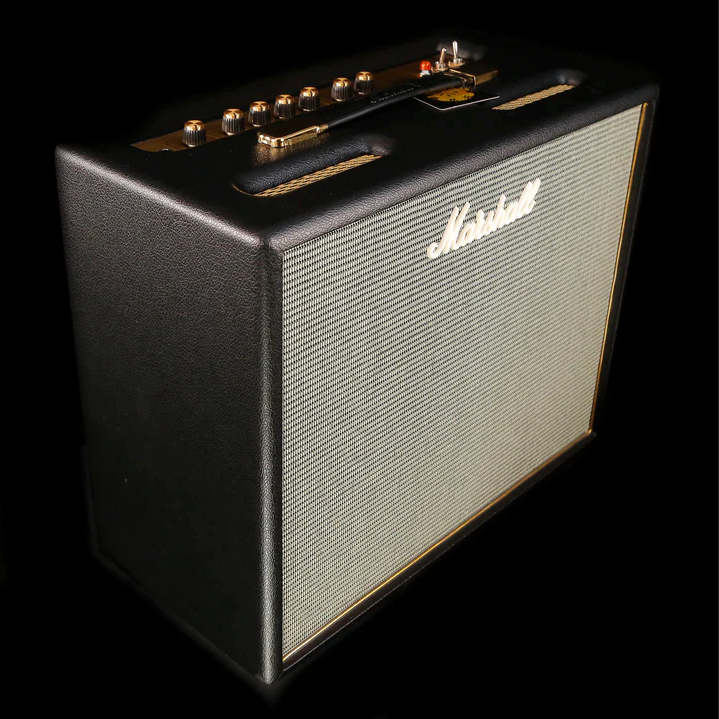 Back to Roots
Back to Roots
I've always wanted the sound of an Early Marshall Plexi in a smaller, quieter form. That British sound we all heard in the early '70s was bold and bright. It has taken nearly sixty years but Marshall has finally come up with a way to shrink the size and quieten down the Plexi sound. They've created a tiny homage to famous JTM-45 1962 "Beano" combo and the 22450 head. While checking out another brand of amp I stumbled across one of the Origin 20H heads being sold used at a nearby guitar shop and was blown away, to put it mildly. I spent a couple of hours checking it out. At that point I was torn between the classic Marsall head style box and the 1x10" combo. Both were enormously attractive, but I eventually narrowed down the best solution to my needs in the Origin 20C combo. This amp has the glassy, ringy, shimmery high end of the classic Plexi amps combined with modern features such as a virtual channel jumpering system and power scaling. It is powered by a pair of full-sized EL34 valves giving it that big boy sound as well. More HERE .
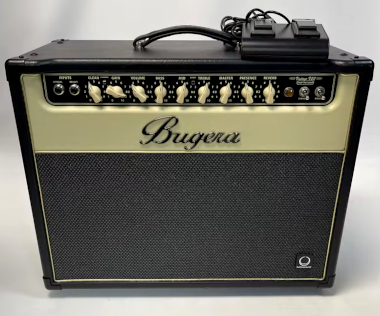 A Surprising Value in an Amplifier
A Surprising Value in an AmplifierHere's something you don't often find: an amp that is a lot of amp for your money. Meet the Bugera V22 Infinium, a twenty-two watt, two channel powerhouse. Between excellent sounds, great features, and a price under $500, it is a LOT of amp. It is based around a pair of EL-84 tubes in push-pull configuration and the "V" in the name hearkens back to the vintage voicing imparted to the amp. However, there are plenty of high-tech features included such as the "Infinium" self-biasing system for the power tubes that extends tube life by up to twenty times and the LEDs on the back to tell you when the power tubes are spent. It is wrapped up with a British-designed TurboSound 12" speaker in a box that is large enough to prevent it sounding boxy. The clean sound is glassy and sparkly and the dirt channel offers some grit. The longer I play it, the more impressed I become. Plus, it is a handsome little devil, isn't it? More pics, HERE, and a review, HERE
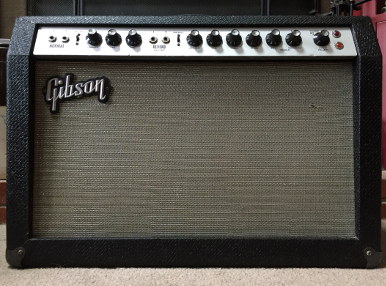 Nostalgia Box
Nostalgia Box
Speaking of thinking outside the box, here's a lovely 1966 Gibson GA-45RVT Saturn amplifier. Back in the 1970s I owned a larger GA-55RVT Ranger which was a 60 watt, 4x10 behemoth known as the "Kalamazoo Super." Idly searching for another Ranger on the Internet I came across this amp in a local store and was intrigued. After visiting it at the store a few times I decided to bring it home. While it shares many features and technical details with the Ranger, it is quite its own beastie. The amp features a dual-6L6 push-pull power section, two ten-inch Gibson Ultrasonic alnico speakers, a smooth, long-tank reverb, a gentle opto-isolator vibrato, and two channels, voiced slightly differently. Oddly opposite to many Fenders, it doesn't begin to bloom until about seven on the dial. Crank it all the way up and it is a fast train back to the '70s. I cleaned it up to look, well, pretty good for a fifty-year-old veteran! Click the pic for a larger version. More on the amp, HERE.
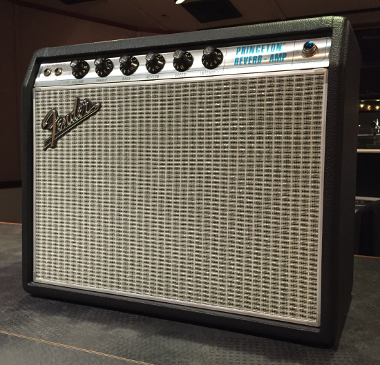 Something Old, Something New...
Something Old, Something New......Something borrowed, something blue. Girls chant this mantra as they prepare for their wedding but I thought it applied well to this re-imagined Fender '68 Custom Princeton Reverb. They've made some changes to the circuit, based upon popular mods, to make this little tyke punch way above its weight class. I came across it and just had to have it for its smooth high end and full bass. It breaks up at a low level than the blackface version and compresses more as well. The trem is probably the best Fender trem I've head as well. It's as simple as can be and only 12 watts strong but it sounds great in the studio and is comfy to me. While they were at it they brought back the 1967 first year Silverface cosmetics including the aluminum drip rail. It takes me back to my first serious amp, but this little hotrod turns the whole Silverface/Blackface discussion on its ear. This particular one features an upgrade Warehouse speaker for less breakup as well. More about it, HERE
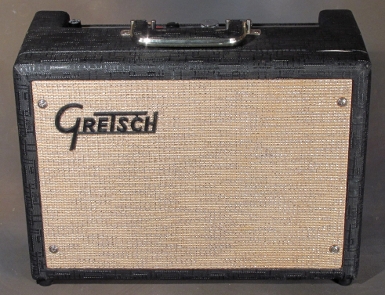 The Mouse That Roared
The Mouse That RoaredThere are some monstrous classic recorded electric guitar sounds that find their genesis in a good guitar and a miniature 1950s-60s practice amp. You can try a million ways to get them but you probably won't, unless you get the right components and go from there. Here's a little 1963 Gretsch 6150T Compact Tremolo, a tiny five-watt bulldog with an eight-inch Jensen "Special Design" speaker. It's been called a "Champ killer" and once you wind it up you find out why - loads of gain and an amazing amount of volume. Once again Class-A goodness in a pocket amp wins out for some things. There are basically only three tubes and three controls: volume, tone, and tremolo speed, and frankly the tone control isn't really much needed because this amplifier changes character as you turn up the volume. Except for the addition of a three-prong power cord this example is basically all-original and pretty close to mint with tolex and grille cloth in spectacular condition. More HERE
 Champagne Taste, Beer Budget
Champagne Taste, Beer Budget
Please tell me you caught the wordplay in that last title. I remember thinking of Fender Champs as toys back in the '70s. While I was thinking about them that way, Derek and the Dominos (featuring Eric Clapton and Duane Allman) were busy recording a Classic album, Layla and Other Assorted Love Songs, with Champs. Surprise, surprise, the Champ is a class-A amplifier design! If you need that class-A sound, I can't think of a cheaper way to get there than a late-'60s - early-'70s silver-face champ. The early Silverface Champs are also virtually identical to their coveted '60s Blackface brethren. Wound out, they give you that bratty, brash sound from Layla. With a little moderation and a humbucker guitar, you can have the Doobie's "Rockin' Down the Highway" rhythm sound. Back off further, and you can "Listen to the Music". Now, mind you, the humble Champ is what good old boys would call "dumber than dirt": You won't find any bells and whistles in this package and with six (6) whopping watts, it can't do "clean" loud enough to compete with, well, just about anything. However, do try out the two inputs: One has higher gain than the other. You can buy all sorts of modification packages and replacement speakers to restore, "tweed", or "hot-rod" a Champ. I picked up a late-1971 Champ for a song. Though it's not all-original (replacement 10" speaker) or very collectable, it is clean and it sounds pretty darned good. Good enough that I've used it to record. It also dates from the early days of my playing career. For safety, it would probably be a good idea to have a tech replace the amp's two-wire power cord with a three-wire, grounded one. Click the image for a larger version. Click HERE for a couple of cool Champ applications. Champlications. Champlifier.
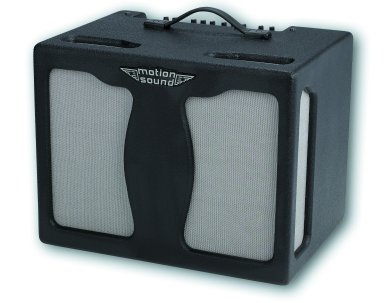 Ooooo... Swirly!
Ooooo... Swirly!
I do love the sound of rotating speaker systems. Here's a Motion Sound AR-112 Sidewinder. After years of wishing for a Leslie rotating speaker system, I came across this cool little rotating speaker combo used. It features a 12" speaker, a 100-watt power amp, and a tube preamp for cool growly sounds. At 40 pounds and little more than the size of a Princeton Recording amp, it's much easier to lug and store as well.
The amp offers an Accutronics spring reverb and pre- and post- gain stage EQ. For easy pickup and connection to a PA, a mic is mounted inside the rotor chamber. The back panel offers a mic input that runs parallel to the guitar jack on the control panel. The unit is finished in a black, textured polymer coating and the speaker openings are filled with dove grey cloth for contrast. The sound is amazingly deep, milky, and swirly, given the unit's size. With this unit's rotor set on slow and another amp on stage, your sound undulates between the two amps. The Sidewinder isn't made anymore so you'll have to look for one used. HERE is a comprehensive review.
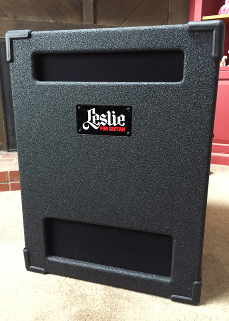 Ooooo... MORE Swirly!
Ooooo... MORE Swirly!
Well, I suppose this is proof that I love the sound of rotating speaker systems. Here's my second one, a Leslie G37. The wonderful portability of the Sidewinder wasn't able to overcome the fact that it was a single-rotor system. There was a level of complexity missing. After seeing Joe Walsh live in 2016 using the G37's big brother, the 3300, I eventually succumbed to tracking down a real Leslie, this 100 pound beastie with two rotors. I have to say that those two rotors make all the difference in the world.
The G37 packs a watt-per-pound and a tube preamp with two gain channels and EQ into a smaller cabinet than those of its forefathers. Speed and braking are fototswitchable with the including footswitch. Gain is also footswitchable if you add a simple latching footswitch. An optional treadle allows you to set the speed anywhere from very low to very high. When the brake is applied, sensors stop the rotors facing forward for best acoustic performance. And the sound? Here is classic Leslie swirl like I've hear it on albums for forty-five years. Clean it is milky. Dirty, using a modeler as a front end, it is gritty and growly. Yum! Yum! Yum! My review is HERE.
 Woodiness
Woodiness
I hadn't planned on liking this amp. I mean I really hadn't. I went to the guitar store while on vacation to check out a Martin guitar and three days later emerged with a Taylor guitar and this amp. Vacation is when the magic happens. I suppose you could say that I have my enabler to blame, but I appreciate her support in more ways than I can express. This is a two-channel, 150 watt Taylor Circa 74 acoustic guitar amp with a ten-inch speaker and facilities for live performance. The basic sound is mellow and smooth and the onboard reverb is gentle if used subtly. Oh, and it has a beautiful mahogany cabinet and a matching mid-twentieth century style stand that makes it elegant enough for the living room, to boot. It is fun to plug in at sunset and let the reverb wash over you as the reds and blues of the sunset fill the room. It is pretty and classy and sounds great as well. More HERE.
 The Sound of England, in a Rack
The Sound of England, in a RackI had always wondered what the Marshall JMP-1 MIDI preamp sounded like from the days when it first came out. Then a generous soul decided to quit rack systems and go back to combos and I was given this rack of goodies to play with. When you run the preamp into the power amp of the Marshall JTM-60 combo mentioned above, you've instantly got that classic Marshall sound in a very neat package. The rack also includes a Rocktron Intelliflex 24-bit Intelligent Effects Processor with echo, reverb, pitch shifting, and chorus, and a Digitech IPS33B Super Harmony Machine. You can go all crazy and sound like an '80s hair band or, like me, use the effects more subtly to enhance your sound. It's all in how you blend the ingredients. Add the second rack that came with it containing a Tubeworks MosValve 962 amp and you are in business!
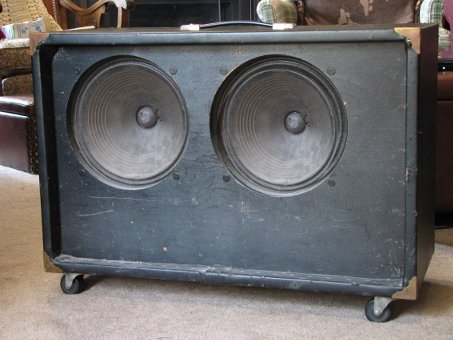 Box of Joy
Box of Joy
Talk about a piece with history: This cab was once a huge, 4x12" Hammond Tone Cabinet built in the 1930s or 40s. In 1975 when I needed a guitar cabinet and couldn't afford it, my father and I cut down the brute into two smaller, more manageable 2x12" cabs. I bought a couple of re-coned speakers at a local guitar dealer and loaded one of the boxes and was rewarded with a lovely, smooth system that became my main cabinet for twenty years. Eventually in the 90s it was damaged by curious little fingers so I tucked it away into storage for a rainy day. Recently when the Traynor amp needed a cabinet, my family helped me refurbish it and bring it back into service! You can read about its former lives, its death, and new life, HERE.
 The Once and Future 'Plex
The Once and Future 'Plex
I first got into the Echoplex EP-3 in the '70s when they were the only Echo game in town. If you know how to take care of 'em, they are dependable units with a really lovely sound that can't be had practically anywhere else. Oh, there were other tape units, but they were complicated and prone to breakdown on stage. The original version featured tube preamps but later ones were all solid-state. I remember Tom Scholtz of Boston and Joe Walsh complaining about the hiss from these units (and rightly so), but they were the best anyway. I picked up an EP-3 (solid-state) and kept it for twenty years. It was in better shape when I sold it than when I bought it! I finally sold it because I thought it was just too darned noisy for recording, both mechanically and electronically. I was an idiot. The Echoplexes didn't have true bypass. They added a little dab of gain and smoothed the highs of the guitar sounds just a bit whether the effect was in or out. In my opinion, the solid state ones sound just as nice as the tube ones and cost much less. Apparently Eric Johnson agrees, because he uses TWO of them in his live rig. I saw 'em with my own two little eyes. I loved mine so much I bought a new/old stock 'Plex off eBay. You can read about it, HERE.
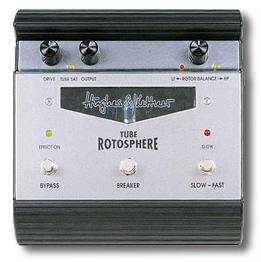 ...The Only Leslie Simulator on the Block
...The Only Leslie Simulator on the Block
The folks at Hughes and Kettner have come up with a wonderful pedal which nicely simulates the sound of a Leslie Tone Cabinet. A Leslie is a powered speaker system featuring a rotating tweeter horn and a woofer which plays through a rotating vane, both of which cause doppler shifts and spread the sound across the stereo field nicely. The Leslie amplifiers are underpowered and usually pushed to the limit to keep up with a band, causing a gritty growl which swirles around and around.
Hughes and Kettner have have fit the Rotosphere with two features which really allow an authentic sound: A 12AX7-based tube preamp which can be easily overdriven for that gentle Leslie "growl" and an acurate simulation of the rotation which realistically mimics the spin and "ballistics" of the original unit. As with a real Leslie, when you change speeds, the unit changes slowly and the tweeter and woofer change speeds at different rates.
I've heard criticism of the unit saying that it is hissy. Having used and maintained Leslies, I know that they are noisy beasts themselves and this unit is much quieter than most real ones. OK, nothing copies a Leslie perfectly but this is pretty darned good. See my full review of the unit and application notes HERE.